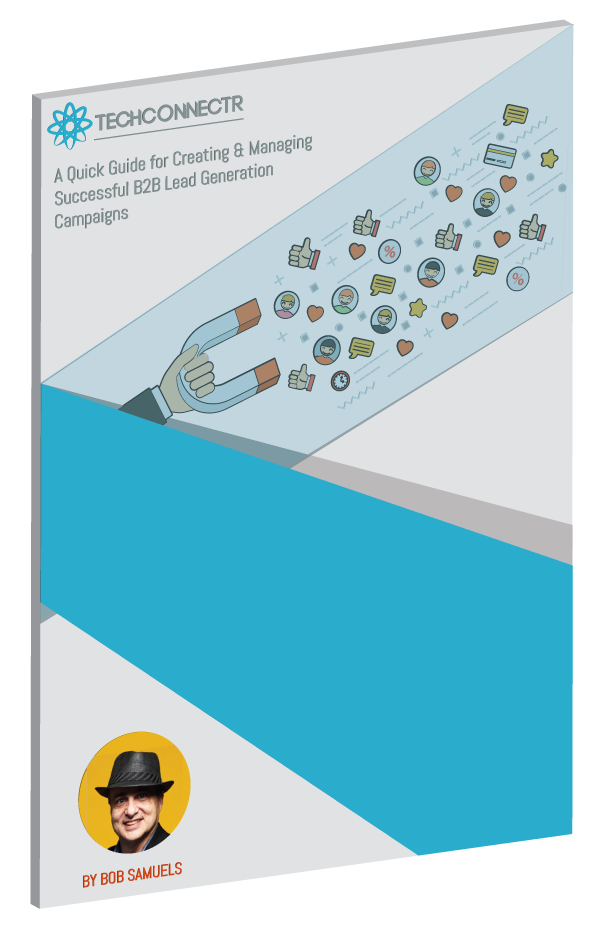Interview with Charlie Tarzian
President Chief Innovation Officer at Aberdeen

VIDEO TRANSCRIPT
Hi this is Bob Samuels founder of tech
connector I have with me Charlie tarzian
who is very sharp data and
particularly intent data marketer and I
look forward to to sharing ideas with
with Charlie so Charlie how are you
today I’m great Bob thanks so much I’m
really happy to be here with you haven’t
seen you in a little while because I
haven’t been to a conference in the last
couple of months but that’s what happens
when you get busy really looking forward
to a great conversation and hopefully
this can contribute to a larger audience
it’s my view that we are at a point
where the more we share and the more we
collaborate the quicker everybody can
get to some form of success which I
think everybody wants so it’s always
great to talk about you know how we do
things and what we believe and what
makes us excited and what are the
challenges and all that stuff so it’s
great to be here beautiful
well I carry your sentiments it’s all
about sharing wisdom and makes everybody
smarter and better so thank you for
doing that can you give us a little bit
of your your background
yes so I’ve been in the data-driven
marketing and sales base for a long time
longer than I’d like to think but it’s
time flies I started in the business in
the late 80s and never looked back and I
came from the technical side so I was
the CTO and back then really building
databases out for the large
multinational holding companies back in
the day you know people like Young &
Rubicam before they became WPP worked at
Wonderman actually rubbed elbows with
some of the great direct marketing
founders of all time Stan draft and
Lester Wunderman so on and so forth and
from there obviously you know starting
around 94 95 is when the internet
started to stick its head up and it
began to blossom I think we made our
first
major buy for Volvo in 1997 I think and
we never you know I never looked back
when I say we I’ve run some
substantially large agency networks
around the world all dedicated to
data-driven marketing services types of
things and then about five five and a
half years ago really started to build
out a platform that would become a
company called the big willow a big
willow is really focused on behavioral
signals and what has now been adopted as
intent data and I think that we’re at a
point now where I think we’re out of the
first or second inning and are really
making the case for why everybody needs
to use it but also really spend a lot of
time with people teaching them how to
use it so it’s really more of a let’s
teach people how to fish and let’s get
some great success out here and so
that’s in a nutshell basically what I’ve
been doing always data-driven always
interested in letting the data tell us
where to go and what direction that we
should take our clients that makes sense
so I’d like to know more about a big
will and and intent it so I hear intent
a lot what what is and it means
different things to different folks I
guess so what is yeah yeah how does that
work and there’s different levels of
different degrees of confidence and I
couldn’t agree more
I think that there’s a lot of hype there
always is but I think having done this
as long as I have I believe that it’s
been oversimplified the whole concept of
intent is to understand how people in
and we’re talking b2b but how people in
the b2b world make decisions and how do
they research things on their way to a
purchase and are they doing that at all
in other words there’s a lot of false
signals that you really want to
understand as well because you don’t
want to be giving data to a client
organization that is not as
specific and focused as anybody would
like so this oversimplification
basically has been hey there’s more
people and more volume in the way that
people are consuming content in this
category therefore there’s a higher
propensity to buy and that gets you into
a lot of trouble because that’s way
oversimplified and so really what intent
and behavioral data is supposed to do
for you is to really understand what are
the shared behaviors what are the
commonalities that companies have on
their way through a buyer journey what
does a buyer journey actually look like
and so on and so forth to get there you
really need to understand client by
client account by account how people who
are eventually either going to buy or
not behave on their way leading up to
becoming a sales opportunity going
through all of the timeframe that record
is required you know there are their
clients that sell infrastructure who
have a timeline of 18 months there are
people who sell SAS products and they
have a timeline of 3 or 5 months and so
on and so forth so every single company
selling different things are going to
have different timelines and the people
that are buying from them or that they
like to buy from them have different
behaviors and it’s really up to us to
understand what that unifying structure
in terms of the shared behavior looks
like so we could use things like machine
learning in order for us to help clients
lock down important moments where they
need to intersect with accounts where
they need to be putting their content in
front of them and so on and so forth so
we’re really at the place now where I
think there’s enough of us that have had
enough experience to take clients to the
next level as it relates to intent but
it’s more than data matter of fact the
data is useless unless you really bring
questions to it and that’s where I get
into the notion of intent performance
and not intent data intent data is
really not a good way to engage people
who have never used it or for people who
have used it in the past
that became frustrated because it was a
little bit oversimplified outstanding so
tell tell me more about intent
performance versus intent data well you
know you know this as much as anybody
that in over the last five years so much
money has been poured into platform
companies and point solutions and
everybody is really trying to solve the
problem so it’s not that people are
wrong to try to solve the problem what
we’ve done is we’ve created more
problems along the way and it all comes
down to a seamless integration and a
move away from certain assumptions that
companies make on their way no matter
how good the data is no have no matter
how good leads are no matter how good
your stack is unless you have a good
foundation everything is really going to
fall apart so it’s really important to
start with the basics and work your way
up to a place where you feel like you
are seeing the kind of result as it
relates to every step of the way and you
know if you look at the funnel right
the the traditional sales funnel a lot
of people will tell you yeah I don’t
really have problems at the top of the
funnel I have plenty of people plenty of
inquiries people on their way to being
qualified I’ve got you know so on and so
forth the amount of breakage in the
marketing sales funnel really takes
place in the middle of the funnel
because if people actually get through
to the end it’s up to sales to really
close and make sure that the
consideration and the information
required to make a decision is all there
in the middle of the funnel there’s a
lot of stuff that happens and that’s
where a lot of our attention is in terms
of helping clients really evaluate what
goes on and what goes wrong in the case
of a closed lost opportunity versus when
they actually went and obviously the
losses are always larger than the wins
and that’s just natural it’s trying to
understand so that as you begin the
process of performance based intent
you’re locking down and you’re
automating
so it goes back to this orchestration
and this automation in incredibly
important moments in time as a company
evaluates you as a company evaluates
your competitors and as they move
through what is considered to be a buyer
journey okay so so the the sources of
your intent data I assume that is from
what people do on Aberdeen sites are you
getting other no not at all not at all
with yeah no no not at all
we we are processing two to three
billion records per night and rolling
that into a taxonomy and the taxonomy
are categories that represent the
product solutions and services that our
clients sell so that said Aberdeen site
itself really doesn’t have that anywhere
close to that volume we’re looking at
right now we monitor about a hundred and
thirty thousand b2b web sites around the
world so we have global coverage and
based on the category we’re looking at
any number of tens of thousands of tech
sites tens of thousands of b2b finance
sites tens of thousands of sites and HR
in aviation and manufacturing and so on
and so forth and so that’s where we get
our signals we’re picking them up from
the relationships we have with trade
publications in the b2b world as well as
participating in and serving a lot of
ads that allow us to see a lot of the
activity leading up to making our
decisions about whether we want to serve
ads to these people so your source of
intent data is more similar to bombora
than tech target I don’t think
it’s either I think both of those
companies are doing we’re all doing it
very differently in the case of tech
target tech target is a publisher and a
very good one
and they probably have and I’m guessing
what they have they might have 150 200
and
again I’m not specifically sure but they
build their own websites and their
structures so they’re categorizing but
they’re living in a very specific tech
target world Bombora I think on their
website says that they have 3,800 sites
that they monitor and so they have a
specific relationship to publishers and
that’s all really well and good and we
think that there’s probably some good
things that that are going to happen
we’re looking at it at a very different
level we’re going out and looking at a
more total totality of the web and not
just a small slice of it I think tech
target is you know from a volume
perspective very small compared to what
we see Bombora is even smaller than I I
think what we see now is anything better
than the other it really depends on how
you bring data science to that picture I
would rather have lots of volume the way
we have it then be very restricted
because you can’t control where people
go and I think that there’s a
demographic issue as you get younger
people in you know let’s say the 25 to
40 category they’re not necessarily
going to conventional or traditional
publishers at all so you want to look
for blogs you want to look for the
peer-to-peer communities you want to
look for the alternatives that are
quality but are not the traditional
forms of publishing I just think so
and there’s other companies out there
like sixsense and to go and everything
and so forth where they help companies
with look-alikes and so forth do you get
into that
well look-alikes of course and we you
have to and that’s the problem with
account based marketing right is that in
account based marketing you know no more
than six to ten percent of your targeted
account list is going to be in market at
any time so you need to find a way to
maximize the effort of your marketing
and sales because if 90% of your market
play
that you’ve selected is really dormant
you have to find look-alikes and that’s
what the real-time marketplace does for
you intent is supposed to deliver to you
a targeted account list of both your
targets and look-alikes so that you’re
optimizing and you’re selecting so that
the prioritization is being is is
allowing you to make really good choices
in terms of how to act around those
things if you only use your targeted
account list and you don’t look it look
likes you’re making a terrible mistake
because you would widen out your total
addressable market incredibly and that
but and that also means what when you
say look like it’s an exact look-alike
of the types of companies the number of
employees the the revenue that the
companies that you’ve already selected
you know in your targeted account list
here’s the problem I I’ve been doing
this for a while and there’s there’s not
a lot of people I’ve met that have
scientifically grown a targeted account
list so there’s been nobody that will
reject look-alikes as long as they’re in
the sweet spot of what they’re looking
for right so do your clients combine
your data with their internal data
absolutely absolutely and there’s a lot
of reasons and a lot of different use
cases for that we have a Salesforce app
we deliver data through into marketing
automation so those are really good
examples of pushing the data and
automating and creating these plays and
and the whole notion of orchestration on
the other hand you want to understand
how everything works together and so we
present data in a comprehensive way for
clients we actually put pixels on our
clients site and that gives us that 360
degree view to say while these three
people came to your site over the last
two weeks this is what they were doing
and this was the content conversation
that they and their colleagues were
having to give more insight into what’s
going on so
absolutely.you ended up with with third
party and first party data that your
yeah which is known as second party data
but yeah we combined both that helps us
with prioritization and scoring it also
helps us with understanding and
integrating into the daily life of
people who count on that is the blood
stream of marketing and sales inside
their company
can you hear me yeah I’m not hearing you
now
so Charlie do you have any of you have any
samples you can share as far as clients
doing really cool things yeah I mean
there’s there’s very different use cases
so I can tell you that we have a client
that’s on record is saying that they are
getting a 40 X return on their
investment in terms of using our
approach but that’s a very sophisticated
client and they have worked really hard
to integrate everything that we do
together so that there’s nothing left on
the table for example there’s a client
that has included us on a global basis
where they were using some of the other
companies that you were naming
previously and they see our data and our
approach as being complementary and in
some cases superior to those other
companies because I think we basically
we see ourselves as data science as a
service and whereas I think a lot of
these companies are delivering data so
while the data is absolutely critical
we’re alongside our clients as an
outsourced data science group really
helping them see the forest through the
trees and I think that’s a big
difference so we we had a big win where
we are now global with with a client
that already has other intent vendors
and that was totally convinced
themselves that ours was really and they
really saw us as unique and
differentiated so that that’s another
one we have another client that and this
is a really good one really large
hardware company that gave us a metric
of $75 for what they call a high value
engagement on their site using our
intent qualified or intent targeted
advertising and we’re now down to $8 we
went so the the agencies that drive
these programs are given a number of $75
after five months we’ve got it down to
$8 you know so there was a really three
different use cases
where we’re totally integrated we’ve
become integrated into the data science
data lake on a global basis at a fortune
50 company and then this other very
large and hardware company is the other
one where we’ve had the significant
performance in terms of using intent to
drive targeted advertising and get the
numbers down for them by 81 percent Wow
so it sounds like you’re you’re you
pointed out I think the the difference
between intent data and intent performance
I think it’s not not just providing the
data but providing the and intelligence
of next steps and what to do with that
yeah and I think I think again the most
important thing I I think to tell the
audience and and many as much of the
audience probably knows this already is
that this requires a commitment and a
process you know it’s it’s not just
gonna fall out of a box you know I
always tell people you have Excel but
you don’t expect Excel to fall out of
the box and run your company it’s the
same thing here it’s we need to do the
right set up the right work the
expectations and assumptions and all
that stuff in order for this to grow
organically because then your marketing
and sales people begin to understand the
differences and they see the differences
but it really takes a commitment you
can’t just have a platform and log in to
it and expect miracles to happen and I
think that’s where a lot of people get
very disappointed is that we need to do
a better job of explaining how to do
this why it’s important and then be all
over the performance the metrics ya know
that’s what’s that that’s really well
said so so my so you’ve been around a
long time and has you seen a lot of
changes what do you see coming up what
do you what do we can be talking about
next year what are we gonna be talking
about five years from now when we talk
about talk about intent data what would
that look like yeah you know that’s a
really good question because in 1996
you probably remember
Regis McKenna wrote that seminal book
called real-time marketing and I think
we’ve been chasing that for the last you
know 30 years or it seems not 30 but 25
years where you know that the technology
has certainly caught up to where what we
want to do in other words I don’t think
any of these companies that exists and
that they’re all doing you know very
varying levels of success they couldn’t
be possible if we were not introduced to
the cloud right and and what Amazon and
Microsoft and others have done is made
this approach affordable so that we can
take a run at all of this data
understand it and then be able to come
out the other end with the
recommendations that need to be
automated right so I think what’s going
to happen is there’s I don’t know in the
next two or three years first of all I
think there’s going to be a lot of
consolidation and I look let’s put it
this way there’s two good news things
for everybody right which is if anyone
had figured this out we would have known
already and you look at people like
Salesforce who are constantly pushing
the envelope and constantly buying
companies and constantly trying to
figure it all out
I could I can tell you honestly they
haven’t figured it out yet it’s and it’s
not for lack of trying and you have to
give them a lot of credit because they
don’t just sit around they’re making
incredible bets and putting resources
and trying to figure things out so
that’s that’s one thing the second thing
is this is really about humans and
understanding human behavior right and
not necessarily artificial intelligence
and it’s going to eliminate everybody’s
jobs I think the disappointment out here
in the community of marketing operations
sales leaders sales operations is that a
lot of people expected to go to jobs and
do some incredible strategic work and
everybody’s wound up in the weeds you
know and you know so somebody like Scott
Brinker who’s wonderful and is really
one of the
leading you know the deleting people who
are driving and articulating a lot of
stuff is really fun it’s funny because I
remember seeing him in the lobby of one
of his shows and he was giving out the
poster with 65-hundred name place on it
and I told him I said I don’t think
that’s very helpful you know that I
don’t think that’s really kind of what
what we’re hoping to achieve which is
just the massiveness of these point
solutions and the confusion in the
marketplace about what I really need it
more to the point I think we need to
back off and recognize that all the
platforms are out there a lot of
commodity stuff a lot of things are on
par with each other it’s the thinking
and the strategy that’s missing and you
know what what I’ve said and and
jokingly of course because I do respect
everyone but you know I say it when I go
to these shows and you and I see each
other all the time I look around and say
there’s a lot of electricians and a lot
of plumbers but we’re the architects
right so a lot of people are trying to
sell point solutions but how do you
architect it and pull it all together
and so but but at the end of the day
getting performance out of it you know
it’s one thing to basically say when I
when I flip a switch I get electricity
and when I turn the tap I get water that
can’t be enough right those are table
stakes it has to be this is where we get
success this is where we get more for
less in terms of our spend in terms of
our resources in terms of you know all
that stuff and it’s all right in front
of us but we have to take the time to
understand the implications how it
changes your organization and the kind
of people you need to interpret the tea
leaves so to be direct I think in the
next two to three years a lot is going
to happen in terms of more automation
more discovery of behavior using
behavioral data and then I think at five
or six years we’re going to I think
we’ve already reached peak in sourcing
meaning I think that we’re going to see
a lot more outsourcing in in the next
three to five years meaning that when I
say peak in sourcing it’s everybody has
their own Marketo instance and everybody
has
eloquence miss and everybody has their
own sales forces and yada yada yada and
I just don’t think there are enough
people that are driving strategy to get
the result that everybody wants I think
there’s a disappointment out here that
no matter how much you train people no
matter how many people you throw at it
you still fall short of performance
because it’s at the strategic level
direct that’s going to happen and what
you feed the stack so you know I would
say taking the words from I think it was
John F Kennedy where you know ask not
your stack to think ask your stack to do
and I think that there’s still a lot of
work to be done on the thinking side I
think the doing side you know everybody
will stand up and say hey and there’s
some really really bright people out
here that are really just you know
trying to get there you know I use these
metaphors but just trying to iron their
shirts right just trying to wake up in
the morning and get through the day and
make sure everything passes through the
this monster spec but at the end of the
day we need to take a lot more time to
look at what the result is and what we
need to do to do better you know a
better result and you know even simple
stuff Bob like did it ever occur to
anybody that PPC is really not very good
for b2b
right why did I say that this is just an
example and by the way I’m not in the
PPC business so I’m not selling anything
I know I don’t do we don’t do that but
what I’m saying to clients is you know
you’re effective PPC and what you’re
spending is a lot more than you think
because a lot of people who are clicking
on your ads you can’t resolve them to an
account you don’t know where they’re
coming from they’re ghosts in the
machine but you’re paying for it
so if 70 80 % of the people clicking on
your PPC ads are not coming from
resolvable IPS to a an account that you
want to do business with then your
effective PPC goes up seven or eight
times right so all of a sudden are you
really spending your money wisely and
the answer is well not really just like
you’ve got some of these people who
think they’re in the intent business and
they’re saying you know you’re going to
pay me X amount of
dollars and when I when I tell clients
that you know these review sites that
are saying they’re in the intent
business and I say to clients but you
your filter for a client you want to go
after is 750 million dollars in revenue
or more and they’re only selling it
sending you 10 or 12 of those a month
but you’re paying them $4,000 a month so
you’re spending $400 per account to tell
you that 2 or 3 people came from that
account and that’s all they’re going to
tell you I said is it really worth that
I mean perform $2 don’t you want an
appointment so I think there there’s a
lot of that that goes on that I think
people really need to look at because at
the end of the day we’re really and I
think everybody in this business really
wants the clients to succeed and who
doesn’t we love to build things and we
love to be right about things but we
want these great clients that we work
for to succeed and I just think there’s
not enough everybody’s running around
with their hair on fire and I don’t
think there’s enough time given to
really think about the larger piece so 5
years from now hopefully we will have
bedded down a lot of the things that
could be automated that are allowing
clients to come in on a Monday and look
at the past week in the rearview mirror
and be satisfied with what they see
because right now I don’t think there’s
a lot of that good stuff charlie thank
you by the way I’m gonna be interviewing
Scott brinker this afternoon oh well Scott
Scott is brilliant and you know he’s
just one of the people that just you
know he’s like the he’s like the would
he call it the the the bunny the the the
battery funny whatever his ever
energizer bunny I mean he’s he’s helped
articulate this world he really thinks
hard about it I think what he does is he
thinks a lot about the technical and
technological repercussions of it and I
love that but we need to have an
equivalent that’s really looking at are
we performing the way that all this
technology put together should be
performing I think that’s the big
question
you know well said beautiful Charlie it’s
always a pleasure to speak with you
thank you for your your you’re sharing
your wisdom well thank you I first of
all I’m flattered that you think it’s
wisdom it’s my experience I don’t know
I’m old enough yet to have wisdom but
because because you know I think I’d
make the same mistake twice a couple
times but anyway I love the opportunity
to first of all can’t wait to see you
again and you know if you want to talk
to some clients let’s go offline and
I’ll make some introductions to you
because they’ll have points of view
outside of us that you want to hear as
well yeah I think that’ll be very
enlightening it’s pleasure charlie and
thanks again thanks Bob appreciate it
take care





